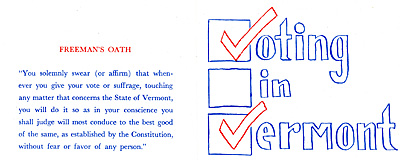Browse Exhibits (4 total)
"As In Your Conscience:" Voting in Vermont


In this online exhibit, we look back at voting in Vermont over the course the state's history. The title of this exhibit is drawn from Vermont's Voters Oath, which was called the Freeman's Oath in 1971 when the League of Women Voters pamphlet above was printed. This exhibit features posters and flyers from 1834-2006 in three categories: ballots (unlike today, ballots were printed by the political parties), instructions to voters on how to cast their ballots, and appeals to voters’ civic duty when selecting a candidate or confronting a controversy. Many of the items in the exhibit were created by partisan campaigns, but others were purely educational.
For more political printed ephemera from the collections of the Vermont Historical Society, see our Political Broadsides collection elsewhere on this website.
"The War of Ideas": Wartime Propaganda Posters

What is the nature of propaganda? How does it differ from marketing or other communications? What messages are important to convey? How are they shared – and by whom?
Wars are extraordinary exercises in propaganda - communications, often exaggerated, meant to advance a particular political point of view. In a democracy, a government must gain the support of its citizens to support a war. One way in which they do this is through visual messaging such as posters.
As you look at the posters, imagine how the words and images – as old-fashioned as they sometimes sound – could be translated to a modern light. Think of how the artists and designers behind these posters used visual cues to motivate and inspire their audience, whatever the time period.
The posters in this exhibit span a century of American wars, from the Civil War to World War II, but many of the messages they bear are timeless.
Barre Italian Life 1890-1920

During the late 19th to early 20th Centuries, the small town of Barre, Vermont grew exponentially. This was due, in part, to the emerging granite Industry, which attracted immigrants from all around the world with promises of better pay and opportunities. Thousands of men from Northern Italy, already having experience with similar stone and carving work, emigrated to the United States hoping to find work in Barre’s granite quarries. This exhibit details a bit about what life would have been like for these Italians living and working in Barre from roughly 1890-1920. It details what work in the granite industry would have been like, as well as what life was like outside of work such as at home or school, different social activities, and the politics of the time.
This exhibit was created by McKenna White, 2023 Lorenzini Fellow
When Women Lead: Governor Madeleine Kunin of Vermont


In 1984 Madeleine Kunin was elected the first female governor of Vermont. For the first time, an inaugural gown was worn by the Governor, not the first lady.
In spring 2020, Governor Kunin donated her three inaugural gowns to the Vermont Historical Society. The gowns were placed on exhibit at the Vermont History Museum in Montpelier from July 2020 - May 2021.
We developed this online exhibit to give context to those three gowns. The exhibit explores Kunin's roles as legislator, governor, ambassador, and mentor.
Featured Exhibit
"The War of Ideas": Wartime Propaganda Posters
What is the nature of propaganda? How does it differ from marketing or other communications? What messages are important to...
